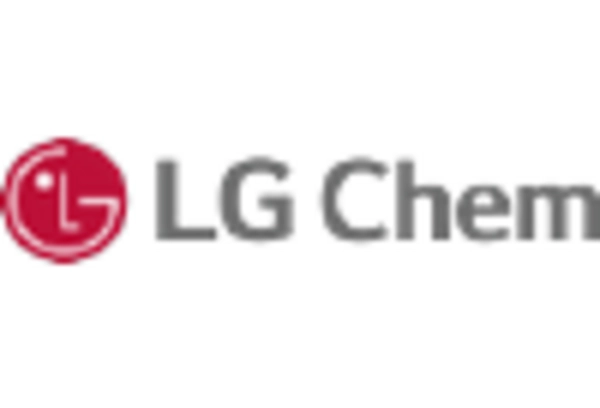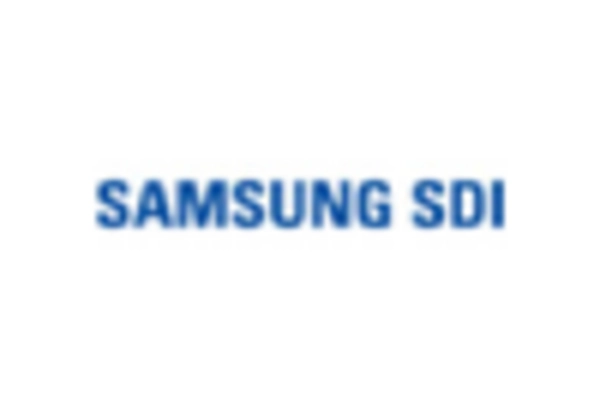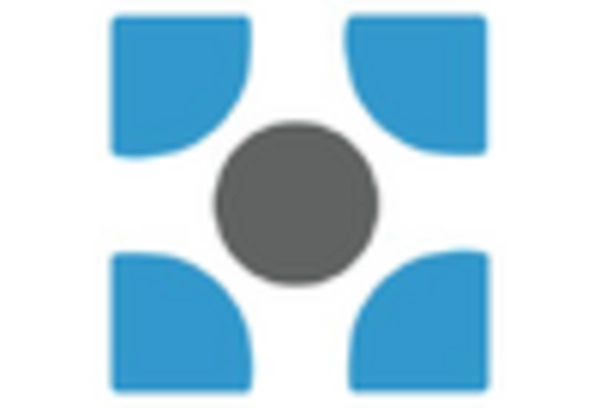Growing Electric Vehicle Adoption
The Solid Electrolyte Market is poised for growth, driven by the increasing adoption of electric vehicles (EVs). As automakers prioritize the development of high-performance batteries, solid-state technology emerges as a viable solution due to its potential for higher energy density and enhanced safety features. Recent statistics suggest that the electric vehicle market is projected to reach over 30 million units sold annually by 2030, creating a substantial demand for advanced battery technologies. Solid electrolytes are expected to play a pivotal role in meeting the performance requirements of next-generation EVs. Consequently, the Solid Electrolyte Market is likely to see significant investments and innovations aimed at optimizing battery performance for electric vehicles.
Increased Investment in Battery Technology
The Solid Electrolyte Market is witnessing a surge in investment aimed at advancing battery technology. Venture capital and corporate funding are increasingly directed towards companies specializing in solid-state batteries, which utilize solid electrolytes to enhance performance and safety. Recent reports indicate that investments in battery technology have reached unprecedented levels, with billions of dollars allocated to research and development initiatives. This influx of capital is likely to accelerate innovation within the Solid Electrolyte Market, leading to the commercialization of advanced solid-state batteries. As competition intensifies, manufacturers are expected to focus on improving the efficiency and scalability of solid electrolyte technologies, further propelling market growth.
Rising Demand for Energy Storage Solutions
The Solid Electrolyte Market is witnessing a notable increase in demand for energy storage solutions, primarily due to the global shift towards renewable energy sources. As countries strive to meet their energy needs sustainably, the need for efficient energy storage systems becomes paramount. Solid-state batteries, which utilize solid electrolytes, offer advantages such as higher energy density and improved safety compared to traditional lithium-ion batteries. Market data indicates that the energy storage sector is expected to expand significantly, with solid-state technology playing a crucial role in this transformation. The Solid Electrolyte Market is thus positioned to benefit from this trend, as manufacturers seek to develop innovative solutions that cater to the evolving energy landscape.
Regulatory Support for Clean Energy Technologies
The Solid Electrolyte Market is benefiting from increasing regulatory support for clean energy technologies. Governments worldwide are implementing policies and incentives to promote the adoption of sustainable energy solutions, including solid-state batteries. This regulatory environment encourages research and development in the Solid Electrolyte Market, as companies seek to align their products with environmental standards. For instance, initiatives aimed at reducing carbon emissions are likely to drive investments in solid electrolyte technologies, which are perceived as more environmentally friendly compared to conventional battery systems. As regulations continue to evolve, the Solid Electrolyte Market may experience accelerated growth, as stakeholders respond to the demand for cleaner energy storage options.
Technological Advancements in Solid Electrolyte Market
The Solid Electrolyte Market is currently experiencing a surge in technological advancements, particularly in the development of new materials that enhance ionic conductivity and stability. Innovations such as sulfide-based electrolytes and polymer composites are gaining traction, potentially leading to higher energy densities in batteries. According to recent data, the market for solid electrolytes is projected to grow at a compound annual growth rate of approximately 25% over the next five years. This growth is driven by the increasing demand for safer and more efficient energy storage solutions, particularly in the automotive and consumer electronics sectors. As manufacturers invest in research and development, the landscape of the Solid Electrolyte Market is likely to evolve, fostering competition and encouraging the adoption of solid-state batteries.


















Leave a Comment